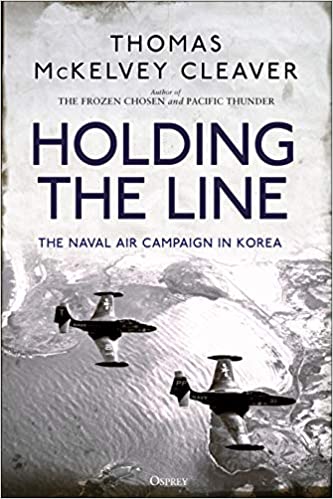Reviewed by Major Chris Ketcherside, USMC (Ret.)
Thomas McKelvey Cleaver’s Holding the Line focuses on carrier-based U.S. naval aviation operations during the Korean conflict. He also touches on related subjects including events on the ground, U.S. Air Force operations and British naval aviation operations. His primary argument seems to be that naval aviation excelled at tactical operations and ground support but was ill suited to the mission of strategic interdiction for which it was often employed.
Holding the Line is divided into 19 relatively short chapters which are organized primarily chronologically but also by subject. For example, Cleaver mentions night fighters and U.S. Marine aviation while describing Operation Strangle—the attempt to cut the North Korean and Chinese forces off from sources of supply via strategic interdiction— but these subjects each get their own subsequent chapters as well. The chapter topics range from specific operations, such as those against the Hwachon Dam, to broader topics like the role of British naval aircraft. Throughout these chapters, he outlines the general situation on the ground in Korea and the political and strategic background to provide context for the reader.
Cleaver is described as a screenwriter, not a historian, in his dust jacket author’s bio. This distinction is evident in Holding the Line’s scholarly missteps. Some issues are relatively minor, such as when he describes Marine air support at Inchon against NKPA T-24s instead of T-34s. Others are more significant, such as his discussion of the atomic attacks on Hiroshima and Nagasaki, which he states were done solely as a deterrent against the Soviet Union. This may be a valid argument, but he presents it as simple fact when it is actually a tremendously complex topic of much historical debate. He treats the death of Stalin similarly, speculating as to whether the dictator was murdered. In both cases, he never directly relates this discussion to the central subject of his book. Moreover, while both of these topics have been addressed in numerous books all their own, it remains unclear whether or not Cleaver is familiar with these readings, as Holding the Line has only a short bibliography and no footnotes whatsoever. This lack of citations constitutes a major problem for scholars.
Cleaver often provides a great deal of detailed information that seems to have little to do with the subject of his book. The second chapter, “Revolt of the Admirals” is a very in-depth discussion of domestic American politics and inter-service rivalries inside the Pentagon as the U.S. military is faced with downsizing in the post-World War II nuclear age. This is informative, but ultimately has little to do with either his central argument or the subject of his book. Starting in Chapter 3, Cleaver also provides detailed technical descriptions of aircraft, such as engine types, climb rates, speeds, payload totals, and so on, but he adds none of his own analysis to these technical details—which may be easily found online—leaving the reader to wonder why they matter and what if any advantage they provided. Cleaver does mention at one point how the “poopy suit” routinely failed as protection from the frigid waters of the ocean, which seems a critically interesting technological subject, but he explores it no further. He also ends most chapters with a summary of dropped bomb tonnage by type but does not address whether this had any strategic effect or was expended to little effect. This numerical data might be central to his argument but the connection is never made explicit.
Lastly, as a pure matter of style, there is very little first-person description of air combat until nearly the last chapter, chapter 17, discussing U.S. Marine aviation. These narratives are gripping, but one wonders why there are virtually none in the other chapters. Surely the Navy pilots had some air-to-air combat memoirs that could have been included.
The focus on Naval aviation has great potential for historical study. While the close air support during the retreat from the Chosin Reservoir has often been discussed, Cleaver covers the roles of naval based aircraft during the entire war. In many places he does this well, such as when he details life aboard aircraft carriers, or the fire on the USS Boxer. His argument is convincing but doesn’t really examine the subject from a new perspective. Overall, the book suffers from a lack of focus and citations.
Major Chris Ketcherside, USMC (Ret.) served in Iraq in 2004. He is now an adjunct professor of history at the Missouri University of Science and Technology and a PhD student at the University of St. Louis.
Holding the Line: The Naval Air Campaign in Korea (Thomas McKelvey Cleaver, Osprey Publishing, Oxford, UK, 2019).


